Uncover the mystery of Og's biblical height and delve into a story where ancient measurements meet legendary giants.
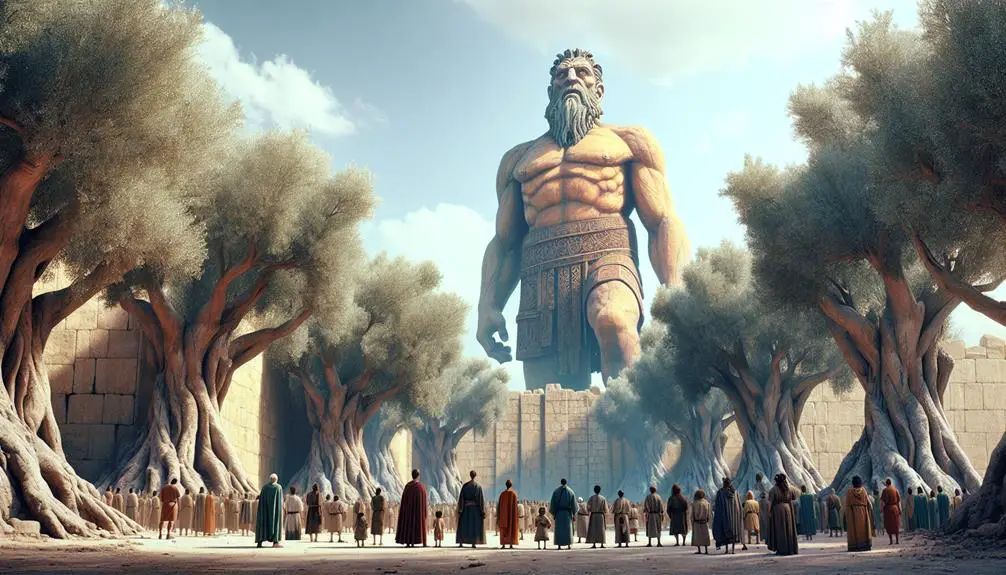
Og in the Bible Height
You might not be aware, but Og, the King of Bashan, is often noted for his extraordinary height in the Bible, yet the specifics can seem as elusive as the legend himself. This ancient text uses the unit of a cubit to describe his bedstead, suggesting a figure larger than life, but converting that into modern measurements leaves room for interpretation.
As we explore the historical and cultural context surrounding Og's mention, you'll find yourself questioning not just the literal height of a man but what his towering presence meant in a world where giants roamed both the earth and the imaginations of those who wrote history.
Key Takeaways
- Og's extraordinary height is indicated by the description of his bedstead, measured in cubits in the Bible.
- Variations in the ancient measurement of the cubit make precise calculations of Og's height challenging.
- Og's diet and lifestyle, as alluded to in biblical texts, may have contributed to his remarkable stature.
- The historical and cultural context of Og's era influences the interpretation of his height in biblical narratives.
The Legend of Og
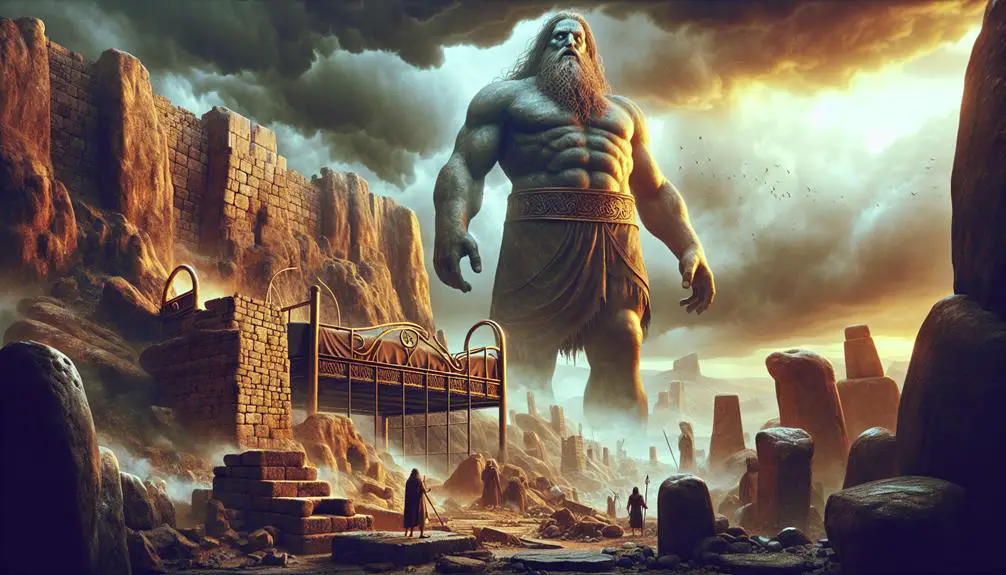
Og, the last of the Rephaim, occupies a fascinating niche in biblical history, embodying the intersection of myth, legend, and historical conjecture. As you delve deeper into the legend of Og, it becomes apparent that his diet plays a crucial role in understanding his mythical stature and the fascination surrounding him. Scholars argue that Og's diet, often described in apocryphal texts, suggests a being of enormous size and strength, requiring vast amounts of food to sustain such a colossal existence. This detail not only amplifies the mythical aura surrounding Og but also serves as a foundation for analyzing the impact of his legend on cultural and religious narratives.
Modern references to Og often draw upon this aspect of his legend, using his dietary habits as a metaphor for gluttony, excess, or the supernatural. In literature and media, portrayals of Og tap into the rich vein of his mythical diet to underscore themes of overindulgence or to highlight the contrast between the human and the divine or monstrous. This intersection of ancient legend and modern interpretation showcases the enduring allure of Og's story, allowing contemporary audiences to explore timeless questions of morality, existence, and the boundaries of human understanding.
In essence, Og's diet isn't merely a trivial detail but a pivotal element that enriches his legend, offering insights into the ancient world's imagination and its lasting influence on modern culture. Through scholarly exploration and artistic depiction, the legend of Og continues to captivate and provoke thought, bridging the gap between the ancient and the contemporary.
Biblical References to Og
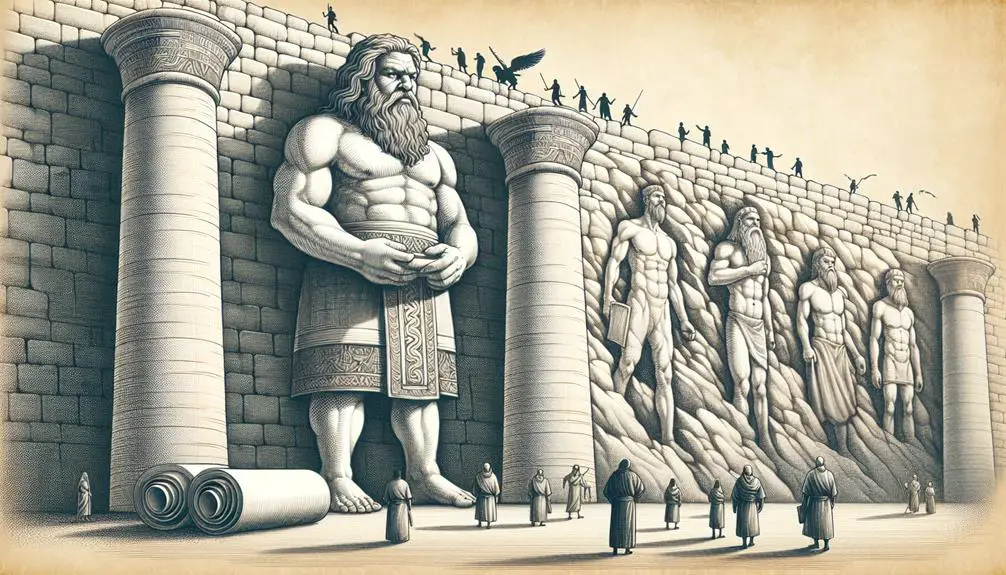
You'll find Og's narrative primarily in Deuteronomy, where his encounters with Israel detail a significant chapter in biblical history. This account not only chronicles Og's defeat at the hands of Israel, highlighting a pivotal moment of triumph, but it also sheds light on the extent of his kingdom and the lasting impact of his legacy.
Og's Mention in Deuteronomy
Mentioned in the Book of Deuteronomy, King Og of Bashan's formidable presence is detailed through passages that highlight his defeat at the hands of the Israelites, underscoring his significance in biblical narratives.
This section provides a crucial link to understanding Og's lineage and sheds light on Amorite customs, offering a window into the societal norms and practices of his time.
Delving into Deuteronomy's account, you're invited to explore the nuances of Og's background, revealing not just the figure of a defeated king, but a representative of a rich cultural heritage.
This exploration into Og's lineage and Amorite customs is essential for piecing together the historical and cultural mosaic that defines this epoch in biblical history.
Og's Defeat by Israel
In the biblical narrative, King Og's defeat by the Israelites marks a pivotal moment, illustrating the culmination of divine intervention and strategic military prowess. This encounter between Og and Israel is dissected through various lenses, emphasizing the contrast between Og's strategies and Israel's tactics.
- Og's strategies: Predominantly reliant on his formidable size and the strength of his forces, aiming to intimidate and overpower.
- Israel's tactics: Leveraged divine guidance, strategic planning, and unconventional warfare methods, demonstrating adaptability and faith.
- Divine intervention: Played a crucial role in tipping the scales, offering Israel not just victory but a decisive one.
- Strategic military prowess: Israel's ability to outmaneuver and exploit weaknesses in Og's defenses underscored their tactical advantage.
This analytical overview sheds light on a complex interplay of faith, strategy, and leadership, pivotal in Israel's historical and spiritual narrative.
Og's Kingdom and Legacy
Having explored the pivotal battle that led to King Og's defeat, we now turn our attention to the kingdom he ruled and the legacy he left behind as depicted in biblical texts. Og's dominion, Bashan, was noted for its fertility and strong cities, a testament to his might and the diplomatic strategies he employed. His alliances, or Og's allies, played a crucial role in his reign, showcasing a complex network of diplomatic relations.
Aspect |
Detail |
Biblical Reference |
|---|---|---|
Og's Allies |
Neighboring Kings |
Deuteronomy 3:1-11 |
Diplomatic Strategies |
Alliances & Treaties |
Numbers 21:33-35 |
Legacy |
Land Division |
Joshua 12:4-6 |
Kingdom |
Bashan |
Deuteronomy 3:10 |
Og's legacy, as illustrated in these texts, underscores his strategic acumen and the indelible mark he left on the biblical narrative.
Understanding Cubit Measurements
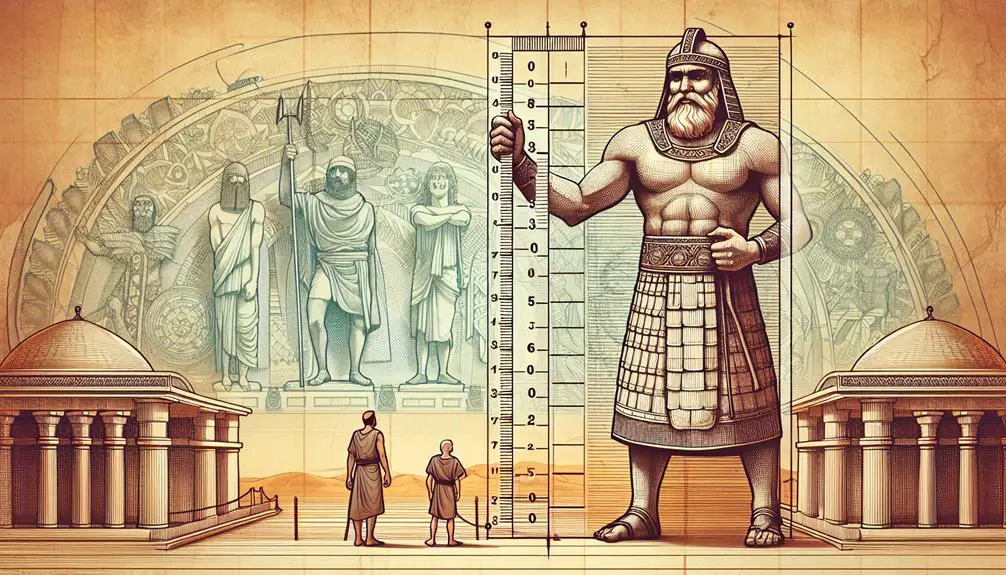
To accurately assess Og's stature as described in the Bible, one must first grasp the cubit, an ancient unit of length typically based on the distance from the elbow to the tip of the middle finger. This measurement, steeped in history, has seen various interpretations and applications across different civilizations. Understanding the cubit is crucial for interpreting ancient texts and archaeological findings accurately.
Cubit history and measurement variations are especially pertinent when discussing figures like Og. The cubit's length wasn't uniform; it varied regionally and over time, influenced by the physical dimensions of the local population and the standardization attempts by different rulers.
Consider these points for a more nuanced understanding:
- Cubit History: Originating in the ancient Near East, the cubit is one of the earliest units of length. Its usage spans several millennia, with evidence of its application found in the construction of monumental architecture, like the Egyptian pyramids.
- Measurement Variations: There were several types of cubits, including the royal cubit, common cubit, and the shorter cubit. The royal cubit is generally longer than the common cubit.
- Regional Differences: The length of a cubit could vary significantly from one civilization to another, with measurements ranging from 18 to 21 inches in today's terms.
- Standardization Attempts: Throughout history, rulers have tried to standardize the cubit to ensure uniformity in construction, trade, and legal proceedings.
Grasping these aspects of the cubit's history and its variations is essential for accurately interpreting mentions of lengths and heights in ancient texts, including the biblical account of Og's height.
Calculating Og's Height

Understanding the cubit's historical context and variability is crucial when attempting to calculate Og's height as mentioned in the Bible. The cubit, an ancient unit of length based on the forearm from elbow to fingertip, varies regionally and historically. This variability impacts our understanding of Og's stature, making it a complex equation.
Cubit Type |
Length (approx.) |
Impact on Og's Height |
|---|---|---|
Royal Egyptian |
52.3 cm |
Taller Estimate |
Common Egyptian |
45.7 cm |
Shorter Estimate |
Hebrew Long |
55.8 cm |
Tallest Estimate |
Given these measures, and considering the Bible describes Og's bedstead as being nine cubits in length, we can infer a range for Og's height. Assuming a bed length typically exceeds its occupant's height by a modest amount for comfort, we're left pondering Og's diet and lifestyle to support such stature. His diet, rich in nutrients or perhaps even divinely influenced, might parallel modern discussions on how nutrition affects physical development.
Analyzing these cubit measurements alongside Og's diet offers a window into the physiology of biblical giants and their lifestyle, drawing intriguing modern parallels. For instance, considering the impact of diet on height in contemporary societies sheds light on the possible realities of Og's existence and physical capabilities. This analysis not only calculates Og's probable height but also invites us to reconsider the interconnectedness of diet, physical stature, and the environment, applicable both in historical and modern contexts.
Historical and Cultural Context
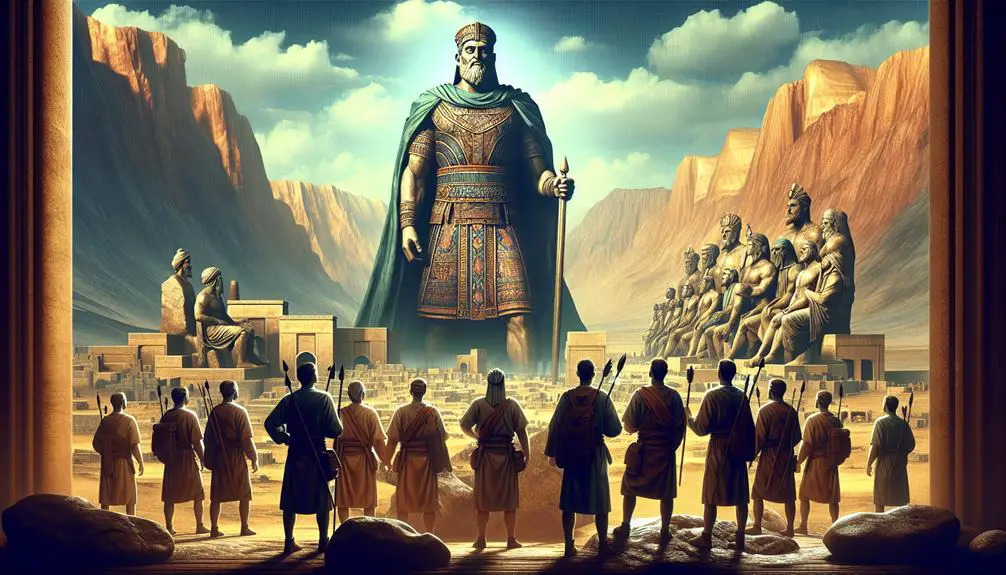
You'll find that the era of Og is of considerable significance, not just for its historical context but for how it shaped cultural beliefs and narratives. The impact of these cultural beliefs on the depiction of Og's height reflects broader societal values and fears of the time.
Moreover, historical interpretations of Og's stature have varied widely, indicating a rich tapestry of myth and history intertwined in ancient texts.
Og's Era Significance
Delving into Og's era reveals its profound impact on historical and cultural contexts of the time, shaping narratives and beliefs in ancient societies. This period was pivotal due to several reasons:
- It highlighted the complexity of ancient alliances, showing how groups navigated their relationships with both friends and foes.
- Regional politics were significantly influenced, as territories expanded or contracted based on the outcomes of battles and treaties.
- The era served as a backdrop for the emergence of legendary figures, contributing to the rich tapestry of ancient lore.
- It also marked a period of technological and military advancements, influencing strategies and fortifications.
These elements combined to underscore the significance of Og's era in understanding the broader historical and cultural dynamics of ancient civilizations.
Cultural Beliefs Impact
Building on the exploration of Og's era, it's crucial to examine how cultural beliefs of the time shaped and were shaped by the historical and cultural context. You'll find that modern interpretations often depend on archaeological evidence to understand these ancient perspectives.
Such evidence reveals how communities venerated figures like Og, possibly reflecting a blend of awe and fear towards perceived giants. This reverence or fear isn't merely a byproduct of their physical attributes but is deeply intertwined with the societal norms and spiritual beliefs of the time.
Cultural narratives surrounding giants were likely influenced by real encounters with unusually large individuals or monumental constructions attributed to them, thus blending myth with a kernel of historical truth. This dynamic interplay highlights the complex relationship between culture and its historical giants.
Historical Interpretations Varied
While the towering figure of Og in biblical narratives captures the imagination, historical interpretations of his stature and significance have varied widely, influenced by the cultural and temporal contexts of those examining the texts.
You'll find that:
- Archaeological evidence has often been scrutinized for clues, yet conclusive connections to the biblical Og remain elusive.
- Giant myths, pervasive in many cultures, shape the understanding and embellishment of Og's story across different periods.
- The lack of physical evidence has led scholars to consider Og's description as symbolic or allegorical.
- The variations in interpretation highlight the complexity of separating historical facts from mythological embellishments.
This analytical journey underscores the challenge in reconciling ancient texts with modern understandings of history and myth.
The Symbolism of Og's Stature
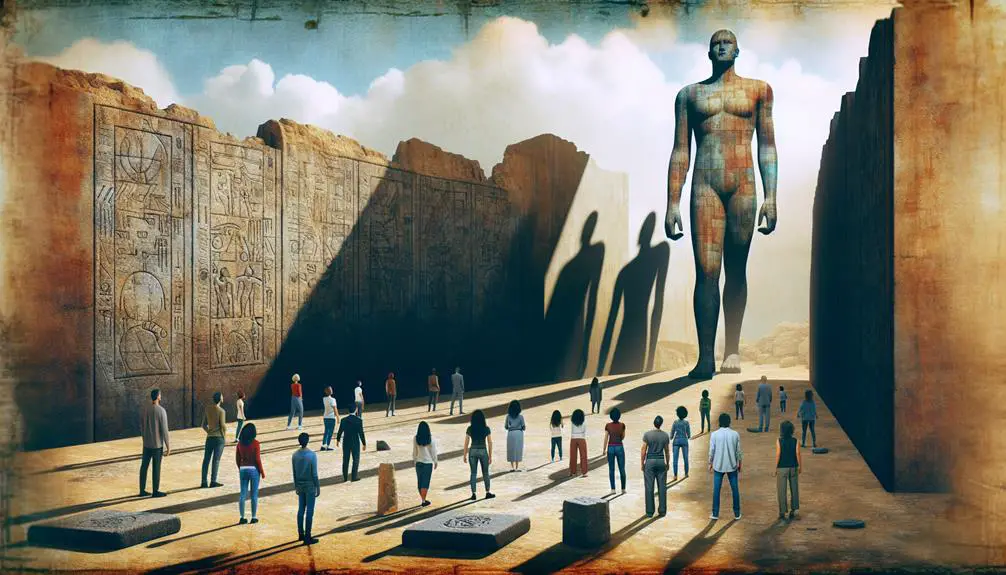
Og's towering stature in the Bible isn't merely a detail of physical description but serves as a profound symbol reflecting various themes and theological concepts. This narrative choice goes beyond simple characterization, delving deep into the realm of giant metaphors and stature myths that are prevalent in many cultures' storytelling traditions. In ancient texts, the depiction of characters with extraordinary physical attributes often hints at their equally significant roles within the narrative, whether as adversaries to be overcome or as embodiments of chaos and disorder.
In the context of Og's narrative, his immense size may symbolize insurmountable obstacles or the pervading presence of evil that the Israelites must confront and overcome. This interpretation aligns with the broader biblical theme of the triumph of faith and divine will over seemingly impossible challenges. Og's stature, therefore, becomes a physical manifestation of the spiritual and moral trials faced by the Israelites, encapsulating the struggle between divine order and chaos.
Moreover, the emphasis on Og's size also serves to magnify God's power and the faithfulness of His followers. By overcoming a giant, the Israelites' victory becomes a testament to their unwavering faith and God's unparalleled might. In this light, Og's extraordinary height transcends mere physicality, evolving into a powerful symbol that reinforces key theological concepts such as divine intervention, the triumph of good over evil, and the importance of faith.
Thus, Og's depiction in the Bible, through the lens of giant metaphors and stature myths, enriches the narrative with deeper layers of meaning, illustrating how physical characteristics can symbolize profound religious and moral truths.
Comparisons With Other Giants
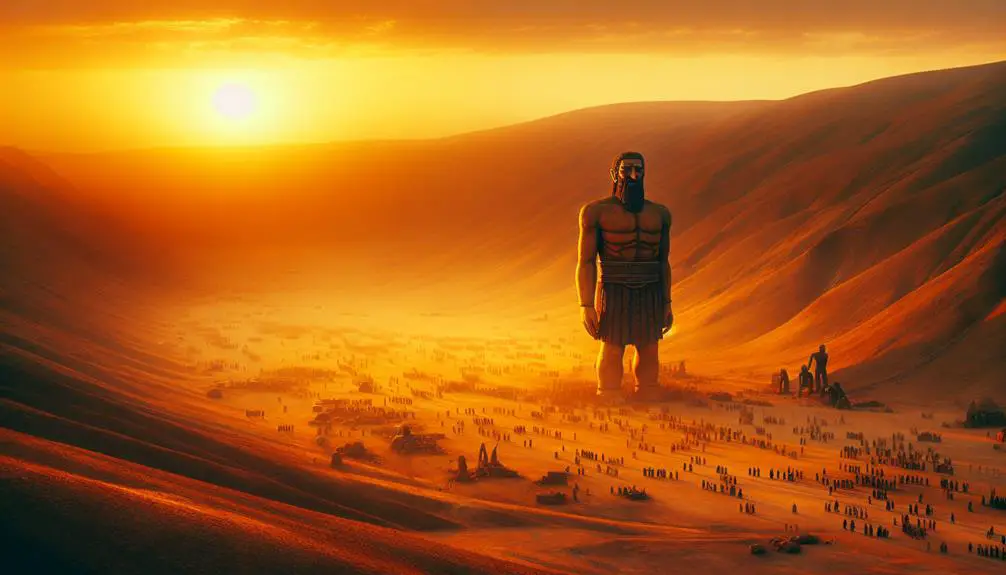
In examining the biblical narrative, it's clear that Og's immense stature isn't unique when contrasted with other giants mentioned in ancient texts, offering rich insights into the cultural and theological significance of such figures. You'll find that the story of Og, while monumental, sits within a broader context of giants that permeate ancient lore, each embodying themes of chaos, heroism, and the divine-human interface.
- Goliath comparison: Perhaps the most famous giant is Goliath, whose defeat by David is a cornerstone of biblical heroism. Unlike Og, Goliath's dimensions are explicitly detailed, providing a tangible scale against which Og's size gains mythical interpretation. The contrast between these figures isn't just physical but also moral and symbolic, highlighting the underdog triumphing over seemingly insurmountable odds.
- Nephilim and Anakim: These groups represent a lineage of giants, with Og often considered a remnant of the Rephaim, a term associated with the Nephilim and Anakim. This ancestral connection enriches the narrative fabric, suggesting a world where the divine and monstrous coexist and interact with humanity.
- Mythical interpretations: The inclusion of giants like Og serves not just as historical or mythical accounts but as vehicles for conveying moral and theological lessons. These stories encapsulate the struggle between order and chaos, human and divine, weakness and strength.
- Cultural significance: The recurring motif of giants across cultures reflects a universal fascination with the extraordinary and the limits of human potential. It underscores a shared curiosity about the world's mysteries and the nature of existence itself.
Through these comparisons, you're invited to explore the deeper layers of meaning behind these towering figures, uncovering the rich tapestry of beliefs, fears, and aspirations that shaped ancient storytelling.
Frequently Asked Questions
How Has the Interpretation of Og's Height Evolved in Modern Biblical Scholarship Compared to Ancient Interpretations?
Modern biblical scholarship has evolved in its interpretation of Og's height by critically examining ancient texts and Og's lineage, alongside historical measurement methods.
You'll find scholars now question traditional, literal interpretations, favoring a more metaphorical or symbolic understanding. They delve into the ancient context, comparing it with modern knowledge to reassess Og's dimensions.
This approach contrasts with ancient views that often accepted fantastical sizes without the scrutiny of contemporary analytical methods.
What Role Does Og Play in Non-Biblical Texts or Traditions Outside of Judaism and Christianity?
In exploring Og's role in non-biblical texts, you'll find his mythology weaves through various cultural adaptations, far beyond Judaic and Christian traditions. Scholars analyze these narratives to uncover how Og's character evolved, emphasizing his legendary status across different societies.
This analysis reveals the adaptability of Og's story, highlighting its ability to resonate and morph within diverse cultural contexts, thus enriching our understanding of his enduring legacy in global mythologies.
Are There Any Archaeological Findings That Have Been Linked to Og or His Kingdom?
You're diving into a mystery that's bigger than finding a needle in a haystack. When it comes to archaeological discoveries linked to Og or his kingdom, the trail is cold. Despite exhaustive searches, Og's artifacts or the precise location of his kingdom remain elusive.
Scholars tirelessly analyze ancient texts and dig through historical layers, hoping to uncover clues. Yet, the tangible evidence remains just beyond our grasp, turning Og's legacy into an intriguing puzzle.
How Has Og's Story Influenced Contemporary Pop Culture, Including Literature, Movies, and Video Games?
Og's story has significantly influenced contemporary pop culture, especially through the lens of giant myths.
You'll find his legacy woven into literature, movies, and video games, where the fascination with pop culture giants thrives.
These adaptations often reimagine or directly reference his mythic stature and tales, enriching the narrative tapestry with ancient roots.
This influence showcases the enduring allure of gargantuan figures in storytelling, bridging ancient lore with modern fascination.
What Psychological or Sociological Theories Have Been Applied to Understand the Fascination With Giants Like Og in Human Culture?
Imagine standing in a vast forest, dwarfed by towering trees. This imagery taps into giant symbolism, reflecting the cultural fascination with beings like giants.
Scholars apply theories like Freud's 'uncanny' to understand this allure, suggesting giants embody both the familiar and the mysterious. Additionally, Jung's archetypes indicate giants represent our shadow selves, embodying fears and aspirations.
These psychological insights unravel why stories of giants captivate human imagination across cultures.
Conclusion
In your journey through ancient texts, you've unearthed the tale of Og, a figure towering not just in stature but in the lore of biblical giants. By dissecting cubit measurements, you've navigated the heights of history, piecing together Og's legendary size.
This exploration, set against a backdrop of cultural and symbolic significance, mirrors the quest of David against Goliath—underscoring the perennial human fascination with the monumental. Og's story, a blend of myth and measurement, invites a deeper reflection on the giants among us, both literal and metaphorical.



Sign up